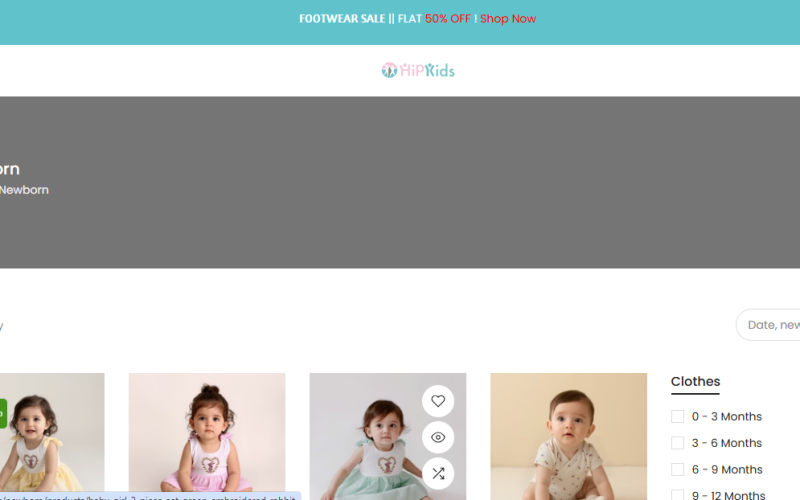INTRODUCTION:
Welcoming a newborn into the world is one of life’s most beautiful experiences. Among the many things parents prepare for, choosing the right newborn clothes stands out as both a joyful and essential task. With so many adorable options in the market today, it’s easy to get overwhelmed. But beyond the cuteness, practicality, comfort, and safety are the real priorities when dressing a newborn.
In this guide, we’ll explore everything you need to know about selecting the perfect wardrobe for your baby—from types of clothes and fabrics to seasonal dressing tips and laundry care.
👶 Why Choosing the Right Newborn Clothes Matters
Newborns are delicate. Their skin is highly sensitive and requires gentle handling. The clothes they wear must protect them from irritation, rashes, and harsh weather conditions. Ill-fitted or low-quality clothing can make your baby uncomfortable and restless.
That’s why choosing newborn clothes isn’t just a fashion statement—it’s a decision that impacts your baby’s comfort and well-being. Newborn clothing should be soft, breathable, easy to wear, and easy to change.
👕 Essential Types of Newborn Clothes to Buy
Here are the must-have items in every newborn’s wardrobe:
-
Onesies/Bodysuits: These are one-piece garments that snap at the crotch, making diaper changes super easy.
-
Sleepers or Rompers: Great for bedtime, they keep your baby warm and cozy through the night.
-
Mittens and Booties: Protect tiny hands and feet from cold air and accidental scratches.
-
Caps/Hats: Help retain body heat, especially important in the first few weeks.
-
Swaddle Blankets: Not clothes per se, but essential for wrapping your baby securely and helping them sleep better.
-
Receiving Gowns: Ideal for the early hospital days—easy to put on and remove.
🌿 Choosing the Right Fabric for Newborns
The best newborn clothes are made from 100% cotton. Cotton is soft, breathable, hypoallergenic, and durable—perfect for a newborn’s sensitive skin. Some parents also opt for bamboo fabric, which is eco-friendly and naturally antimicrobial.
Avoid synthetic fabrics like polyester or nylon, especially in warmer climates, as they trap heat and can cause skin irritation.
Look for clothing with flat seams, no tags (or soft ones), and gentle elastic bands. Natural dyes and chemical-free fabrics are highly recommended.
📦 How Many Clothes Do You Really Need?
Babies grow fast—and they’re messy. Spit-ups, diaper leaks, and drool are part of daily life. Still, there’s no need to overbuy. Here’s a basic list for the first few months:
-
6–8 bodysuits/onesies
-
3–4 sleepers
-
2–3 hats
-
2–3 pairs of mittens and booties
-
4–5 swaddle blankets
-
1–2 jackets (for colder climates)
Pro tip: Always buy one size larger than the baby’s current size. Newborns often outgrow their clothes in just a few weeks.
🧼 Laundry Tips for Newborn Clothes
It’s not just about buying the right clothes—it’s also about keeping them clean and safe.
-
Use baby-safe detergent: Choose a fragrance-free, hypoallergenic laundry detergent designed for infants.
-
Wash new clothes before first use: This removes any factory residue or potential allergens.
-
Avoid fabric softeners: They may irritate your baby’s skin.
-
Separate baby laundry: Wash baby clothes separately from adult clothes to prevent cross-contamination.
🌦 Dressing for the Season
-
Summer: Lightweight cotton bodysuits and short-sleeved outfits. Keep baby cool but covered to avoid sunburn.
-
Winter: Layer up with fleece or wool-lined rompers, socks, mittens, and hats. Use a warm blanket or a bunting bag for outings.
-
Rainy Season: Waterproof booties and a soft, quick-drying outer layer are useful, especially when stepping out.
The idea is to keep your baby comfortable without overheating or exposing them to cold.
🛍️ Tips for Smart Shopping
Here are some quick tips to make the best choices when shopping for newborn clothes:
-
Opt for practicality over appearance. Cute outfits are great for photos, but daily wear should be all about ease.
-
Buy in advance, but not in excess. You’ll receive plenty of gifts—so don’t overstock.
-
Check for safety features. Avoid clothes with loose buttons, drawstrings, or rough zippers.
-
Choose easy-open designs. Snap buttons or zip-front outfits are easier during diaper changes.
-
Prefer gender-neutral options. Especially useful if you’re planning to have more than one child.
🌍 Sustainable and Eco-Friendly Options
A growing trend among new parents is choosing sustainable newborn clothes. Brands now offer eco-conscious collections made from organic cotton, bamboo, or recycled materials. These clothes not only care for your baby but also reduce your carbon footprint.
Many parents are also exploring second-hand clothing platforms. Since newborns grow so fast, most used baby clothes are in excellent condition—and it’s a smart, budget-friendly option.
👨👩👧👦 Final Thoughts:
Your newborn’s early days are precious, and dressing them should be a joyful experience. Choosing the right newborn clothes can keep your baby safe, happy, and comfortable—all while making them look absolutely adorable.
Remember: quality over quantity, comfort over style, and practicality over trend. Whether you’re shopping for your first baby or building a gift list, thoughtful clothing choices will go a long way in ensuring your newborn’s well-being.












